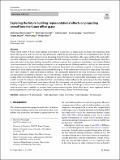Exploring the future building : representational effect on projecting oneself into the future office space
Abstract
While virtual reality (VR) has been explored in the field of architecture, its implications on people who experience their future office space in such a way has not been extensively studied. In this explorative study, we are interested in how VR and other representation methods support users in projecting themselves into their future office space and how this might influence their willingness to relocate. In order to compare VR with other representations, we used (i) standard paper based floor plans and renders of the future building (as used by architects to present their creations to stakeholders), (ii) a highly-detailed virtual environment of the same building experienced on a computer monitor (desktop condition), and (iii) the same environment experienced on a head mounted display (VR condition). Participants were randomly assigned to conditions and were instructed to freely explore their representation method for up to 15 min without any restrictions or tasks given. The results show, that compared to other representation methods, VR significantly differed for the sense of presence, user experience and engagement, and that these measures are correlated for this condition only. In virtual environments, users were observed looking at the views through the windows, spent time on terraces between trees, explored the surroundings, and even “took a walk” to work. Nevertheless, the results show that representation method influences the exploration of the future building as users in VR spent significantly more time exploring the environment, and provided more positive comments about the building compared to users in either desktop or paper conditions. We show that VR representation used in our explorative study increased users’ capability to imagine future scenarios involving their future office spaces, better supported them in projecting themselves into these spaces, and positively affected their attitude towards relocating.
Citation
Weerasinghe , A M , Copic Pucihar , K , Ducasse , J , Quigley , A J , Toniolo , A , Miguel , A , Caluya , N & Kljun , M 2022 , ' Exploring the future building : representational effect on projecting oneself into the future office space ' , Virtual Reality , vol. First Online . https://doi.org/10.1007/s10055-022-00673-z
Publication
Virtual Reality
Status
Peer reviewed
ISSN
1359-4338Type
Journal article
Description
The authors acknowledge the European Commission for funding the InnoRenew CoE project (Grant Agreement 739574) under the Horizon2020 Widespread-Teaming program and the Republic of Slovenia (Investment funding of the Republic of Slovenia and European Union of the European Regional Development Fund). We also acknowledge support from the Slovenian research agency ARRS (program no. P1-0383, J1-9186, J1-1715, J5- 1796, J1-1692, and IO-0035).Collections
Items in the St Andrews Research Repository are protected by copyright, with all rights reserved, unless otherwise indicated.

